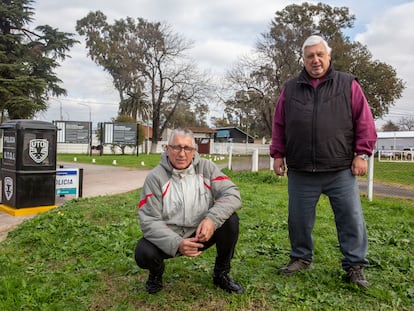Artificial intelligence imagines what babies stolen by Argentina’s military dictatorship would look like today
Argentine artist Santiago Barros uses AI and photographs of the disappeared parents — which are kept in an archive maintained by the Grandmothers of the Plaza de Mayo — to create the portraits
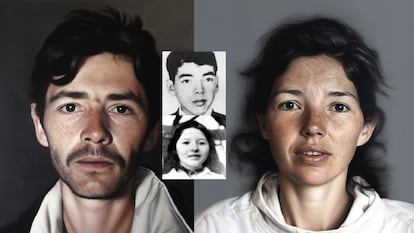

This past April, a man had a genetic analysis done in Buenos Aires. His name hasn’t been made public, but this past Friday, all of Argentina learned his story. He was the son of Cristina Navajas — a woman who was kidnapped in 1976 by her country’s military dictatorship (1976-1983). She was 27-years-old and just a few weeks pregnant. The baby was born in captivity and handed over to a powerful family. His true identity was denied for decades. On July 28, he became the 133rd grandchild that the Grandmothers of the Plaza de Mayo — a human rights organization with the goal of finding the children stolen and illegally adopted during the regime — have recovered. He is 46-years-old and has just met his real family.
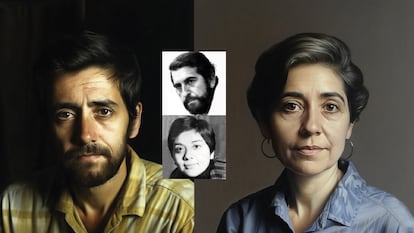
Since the early-1980s, the Grandmothers have used an infallible method of recovering missing grandchildren. The genetic data of the families they are looking for are stored in a public file — the information is checked against those who knock on the door with doubts about their true identity. But the only way to find a grandchild is for the stolen children, who are now grown up, to decide to get a DNA test. This process is something that the Grandmothers have promoted with public-awareness campaigns that even Lionel Messi has taken part in.
This past week, while the Grandmothers were preparing the announcement of the recovery of a new grandson, an artistic project has become one of the most widespread campaigns of recent times. Santiago Barros, a 46-year-old artist, has recreated how around 50 people born in clandestine detention centers or kidnapped by the military dictatorship in the 1970s would look like today. His work, which he publishes on an Instagram account called IAbuelas, has appeared in practically all national media outlets. He now has more than 10,000 followers.
“Artificial intelligence cannot generate portraits with scientific parameters. This isn’t a search tool for Grandmother — it’s just an exercise in memory and an indictment [of the past],” warns Barros, in conversation with EL PAÍS. “It’s a reminder of the horror, that these crimes happened and continue to happen. A person with an expropriated identity is a crime that continues to be committed today.”
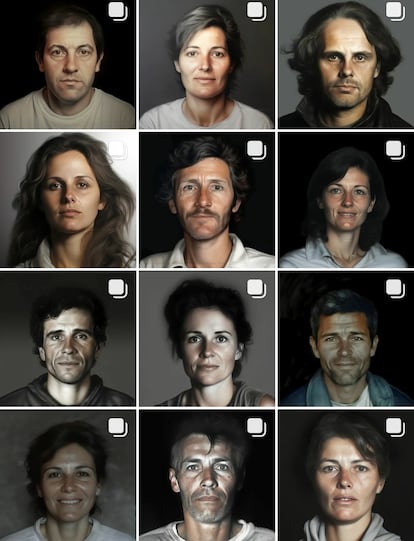
The process, he describes, is simple: he uses the Midjourney app, which creates the image of the child from the parents’ portraits. In most cases, Barros relies on the archive of photographs kept by the Grandmothers of the Plaza de Mayo. However, he notes that many families have sent him more photographs to be used in his work. “I upload the photos to the app and ask them to [mix the features] of, say, a 45-year-old man and woman. I intervene when I see that these people have a noticeable feature,” he explains. “I was interested in going beyond a very established idea: when we refer to disappeared grandchildren, the idea is that they’re babies, because they were appropriated at birth [or when they were a few months old]. But now, they’re my age.”
With @IAbuelas, Barros has been able to recreate what those stolen children would look like today. In most cases, he publishes portraits of both men and women, with no certainty about dates or gender. In others, he has more data. Barros has been able to imagine what people like Clara Anahí Mariani — who would be 47-years-old on August 12 — would look like, thanks to the available portraits of her parents. Clara Anahí was kidnapped when she was just over three-months-old. The daughter of Diana Teruggi Daniel Mariani, she was born on August 12, 1976. She was the only survivor of the attack on her home that killed her mother and four other Montoneros militants, the armed wing of the resistance. The photograph that was taken of her when she was a baby is one of the iconic images of that tragic time.
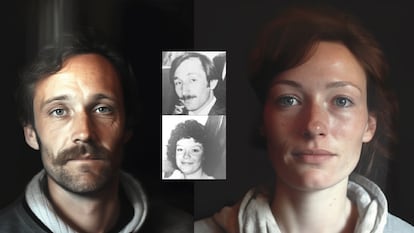
The Grandmothers of Plaza de Mayo have stated that they appreciate the “the permanent solidarity” of this kind of initiative, which supports their search. However, the organization has emphasized in a statement that “this initiative isn’t scientific, but artistic-playful. The only infallible method to link a grandson or granddaughter with their family of origin is through a genetic match via the National Genetic Data Bank.”
“We acknowledge that this IG account is impressive because of the faces it throws up. But, nonetheless, it lacks accuracy in its results. If you don’t look like any of those faces, you might as well be one of the grandchildren we’re looking for.”
Sign up for our weekly newsletter to get more English-language news coverage from EL PAÍS USA Edition
Tu suscripción se está usando en otro dispositivo
¿Quieres añadir otro usuario a tu suscripción?
Si continúas leyendo en este dispositivo, no se podrá leer en el otro.
FlechaTu suscripción se está usando en otro dispositivo y solo puedes acceder a EL PAÍS desde un dispositivo a la vez.
Si quieres compartir tu cuenta, cambia tu suscripción a la modalidad Premium, así podrás añadir otro usuario. Cada uno accederá con su propia cuenta de email, lo que os permitirá personalizar vuestra experiencia en EL PAÍS.
¿Tienes una suscripción de empresa? Accede aquí para contratar más cuentas.
En el caso de no saber quién está usando tu cuenta, te recomendamos cambiar tu contraseña aquí.
Si decides continuar compartiendo tu cuenta, este mensaje se mostrará en tu dispositivo y en el de la otra persona que está usando tu cuenta de forma indefinida, afectando a tu experiencia de lectura. Puedes consultar aquí los términos y condiciones de la suscripción digital.
More information
Archived In
Últimas noticias
Most viewed
- Reinhard Genzel, Nobel laureate in physics: ‘One-minute videos will never give you the truth’
- Oona Chaplin: ‘I told James Cameron that I was living in a treehouse and starting a permaculture project with a friend’
- Pablo Escobar’s hippos: A serious environmental problem, 40 years on
- Charles Dubouloz, mountaineering star, retires at 36 with a farewell tour inspired by Walter Bonatti
- Why we lost the habit of sleeping in two segments and how that changed our sense of time

